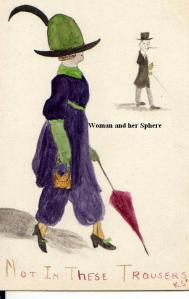Posts Tagged collecting suffrage
Collecting Suffrage: The Hunger Strike Medal
Posted by womanandhersphere in Collecting Suffrage on August 11, 2012
 One of the most iconic items to add to a suffrage collection is a WSPU hunger-strike medal.
One of the most iconic items to add to a suffrage collection is a WSPU hunger-strike medal.
These medals were first presented by the WSPU at a ceremony in early August 1909, given to women who had gone on hunger strike while serving a prison sentence handed down as punishment for an act of suffrage militancy.
The medals comprise a silver pin bar engraved ‘For Valour’, a hanging length of ribbon in the purple, white and green colours, and either a silver or a striped enamel bar, from which hangs a silver circle with the name of the presentee on one side and ‘Hunger striker’ on the other. If the ribbon terminates in a silver bar, this is engraved with a date denoting the day of the owner’s arrest. The enamelled purple, white and green bars are engraved on the reverse, for example sculptor Edith Downing’s medal that I once sold is engraved with ‘Fed by Force 1/3/12’. This was the date of her imprisonment that resulted in a hunger strike and forcible feeding.
Some medals, such as the one Emily Wilding Davison is wearing in my 6 August ‘Suffrage Stories’ post, carry more than one bar, indicating multiple hungerstrikes.
Each medal was presented in a purple box, with a green velvet lining. As can be seen in the photograph, a piece of white silk that originally went inside the lid was printed in gold with: ‘Presented to [name] by the Women’s Social and Political Union in recognition of a gallant action, whereby through endurance to the last extremity of hunger and hardship a great principle of political justice was vindicated’.
These medals were made by Toye, a well-known Clerkenwell firm, and cost the WSPU £1 each – the medals now sell for thousands of pounds. They were treasured by their recipients who , in their old age, still proudly wore them on suffrage occasions; they are treasured today by collectors who recognise the bravery of the women to whom they were awarded.
Suffragette postcards: harem pants 2
Posted by womanandhersphere in Collecting Suffrage on August 1, 2012
‘Not In Those Trousers’  is the caption to a hand-painted postcard (the artist has initialed it ‘K.S.’). The subject of the remark is a lady in a purple and green outfit – a long tunic over ‘harem’ trousers – wearing a green and purple hat and carrying an umbrella. The author of the remark, a dapper gentleman, stands in the background.
is the caption to a hand-painted postcard (the artist has initialed it ‘K.S.’). The subject of the remark is a lady in a purple and green outfit – a long tunic over ‘harem’ trousers – wearing a green and purple hat and carrying an umbrella. The author of the remark, a dapper gentleman, stands in the background.
I think that, in this case, the deliberate choice of colours may indicate that a suffrage inference might be drawn. The style of dress is, again, very Paul Poiret – see this week’s ‘Suffrage Stories: ‘Madame Mantalini’ post.
Very good – unposted. The reverse of the card has a rectangle marked – in the top right – to receive a stamp ‘Inland Postage 1/2d. Foreign Postage 1d.’ £15 post free.
To buy: email e.crawford@sphere20.freeserve.co.uk
[Woman and her Sphere logo on the image here is not, of course, on the original card]


 I have only ever had in stock – and that only fleetingly – this cup and saucer (see left), part of the third identifiable range of WSPU-commissioned china. I believe, however, that the People’s Palace in Glasgow holds a similar two pieces . They formed part of the Scottish version of the Prince’s Rink tea service, commissioned from the Diamond China Co, another Longton pottery, for use at the refreshment stall at the Scottish WSPU Exhibition held in Glasgow at the end of April 1910. Here the ‘angel of freedom’ is allied, on white china, with the Scottish thistle, handpainted, in purple and green, inside transfer outlines. After the exhibition this china, too, was sold – Votes for Women, 18 May 1910, noting that ‘a breakfast set for two, 11s; small tea set 15s , whole tea set £2, or pieces may be had singly’. It will hardly surprise readers to learn that WSPU china – now so very rare – commands a very high price. But what a wonderful addition a piece would make to any suffrage collection.
I have only ever had in stock – and that only fleetingly – this cup and saucer (see left), part of the third identifiable range of WSPU-commissioned china. I believe, however, that the People’s Palace in Glasgow holds a similar two pieces . They formed part of the Scottish version of the Prince’s Rink tea service, commissioned from the Diamond China Co, another Longton pottery, for use at the refreshment stall at the Scottish WSPU Exhibition held in Glasgow at the end of April 1910. Here the ‘angel of freedom’ is allied, on white china, with the Scottish thistle, handpainted, in purple and green, inside transfer outlines. After the exhibition this china, too, was sold – Votes for Women, 18 May 1910, noting that ‘a breakfast set for two, 11s; small tea set 15s , whole tea set £2, or pieces may be had singly’. It will hardly surprise readers to learn that WSPU china – now so very rare – commands a very high price. But what a wonderful addition a piece would make to any suffrage collection.



